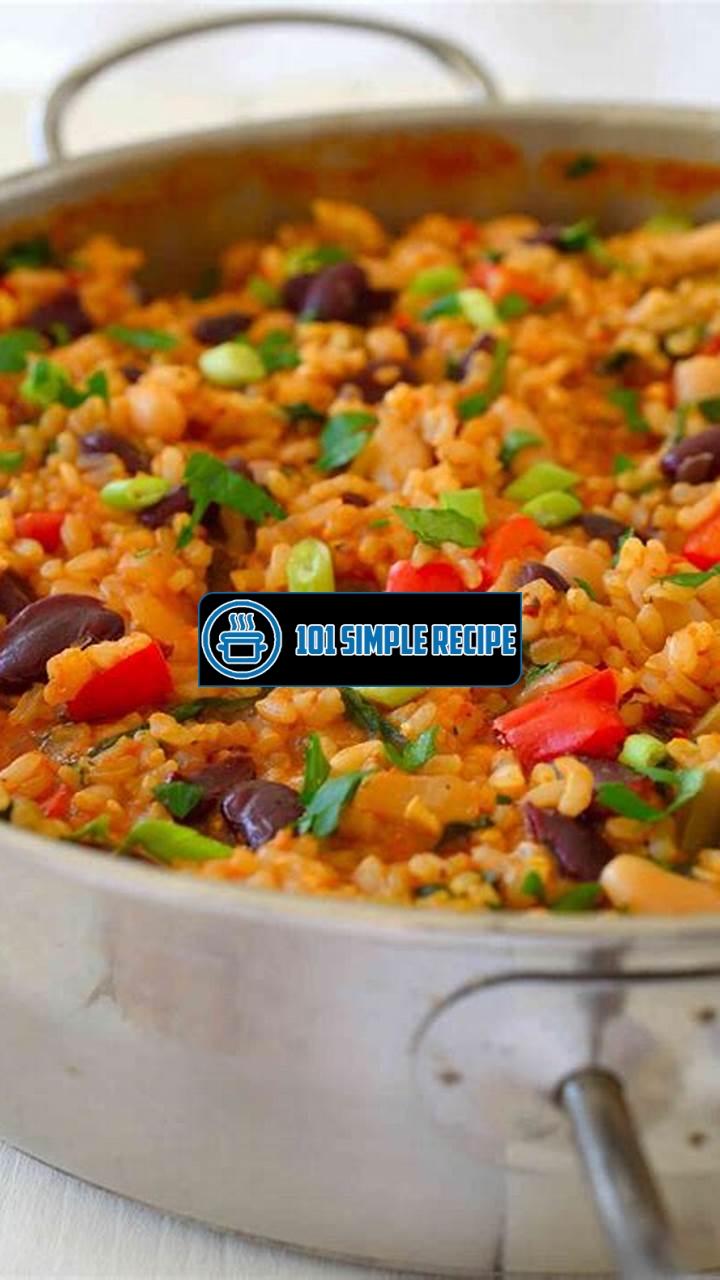If you’re looking for a delicious and easy vegan jambalaya recipe that will satisfy your taste buds and leave you wanting more, look no further! This mouthwatering dish is packed with flavors and textures that will have you coming back for seconds. Whether you’re a seasoned vegan or just looking to explore new plant-based options, this recipe is sure to impress. Get ready to dive into a bowl of aromatic spices, hearty vegetables, and tender rice that come together to create a symphony of flavors. With just a few simple steps, you’ll have a delectable vegan jambalaya ready to enjoy in no time. Let’s get cooking!

What is Vegan Jambalaya?
Jambalaya is a beloved dish that originates from Louisiana, USA. It is a flavorful and spicy rice-based dish that traditionally includes a variety of meat and seafood, such as chicken, sausage, and shrimp. However, with the rise in popularity of vegan diets, a vegan version of this classic dish has emerged. Vegan jambalaya swaps out the meat and seafood for plant-based alternatives, making it a delicious and cruelty-free option for vegans and non-vegans alike. In this article, we will delve into the history and cultural significance of jambalaya and explore what makes a vegan jambalaya so tasty.
History and Cultural Significance
Jambalaya has its roots in the diverse cultural background of Louisiana. The dish is believed to have been inspired by Spanish paella and African jollof rice, as Louisiana was influenced by both Spanish and West African cultures. Over time, the dish became a staple in Creole and Cajun cuisine, known for its bold flavors and rich history.
Not only is jambalaya an important part of Louisiana’s culinary heritage, but it also holds cultural significance. It is often associated with gatherings and celebrations, such as Mardi Gras and family reunions. Jambalaya is a dish that brings people together, symbolizing the warmth and hospitality of the region.
What Makes a Vegan Jambalaya?
A vegan jambalaya follows the same basic principles as the traditional version: it is a one-pot dish made with a flavorful base of onions, bell peppers, and celery, commonly known as the “holy trinity” in Cajun and Creole cooking. However, instead of meat and seafood, plant-based proteins like tofu, tempeh, or seitan are often used.
To mimic the smoky and savory flavors of the original jambalaya, vegan versions often incorporate ingredients like liquid smoke, paprika, and nutritional yeast, which add depth and complexity to the dish. These flavor-enhancing ingredients, combined with the aromatic spices, such as cayenne pepper, thyme, and bay leaves, create a delicious vegan jambalaya that rivals its non-vegan counterpart.
Ingredient Substitutions for Non-Vegan Ingredients
When making a vegan jambalaya, it’s important to find suitable substitutes for non-vegan ingredients. Here are some common substitutions:
- Meat: Instead of animal-based proteins, use plant-based alternatives like tofu, tempeh, seitan, or vegan sausage.
- Seafood: Replace shrimp or shellfish with plant-based alternatives such as vegan shrimp, hearts of palm, or artichoke hearts.
- Stock: Use vegetable broth or water instead of meat-based stocks to maintain the flavorful base of the dish.
- Butter and Dairy: Substitute butter with plant-based margarine or oil, and replace dairy products like cream or cheese with vegan alternatives.
With these ingredient swaps, you can enjoy a delicious vegan jambalaya that not only satisfies your taste buds but also aligns with your dietary choices.
In summary, vegan jambalaya is a plant-based twist on the classic Louisiana dish that incorporates flavorful plant-based proteins and substitutes for non-vegan ingredients. With the right combination of spices, seasonings, and vegetable-based alternatives, you can create a mouthwatering vegan jambalaya that delights your taste buds and leaves you wanting more.
Benefits of a Vegan Jambalaya
When it comes to enjoying a delicious and nutritious meal, a vegan jambalaya recipe is an excellent choice. This popular dish offers a myriad of health and environmental benefits that make it an appealing option for vegans and non-vegans alike.
Plant-Based Proteins for Sustained Energy
One of the key advantages of a vegan jambalaya is the abundance of plant-based proteins it provides. By substituting traditional animal proteins with ingredients like beans, lentils, and tofu, you can enjoy a hearty and satisfying meal while reaping the benefits of sustained energy. These plant-based proteins are packed with essential nutrients and amino acids that fuel your body, helping you feel energized throughout the day. Additionally, they are often low in saturated fats, making them a heart-healthy alternative to traditional jambalaya.
Fun fact: Did you know that legumes, such as beans and lentils, are an excellent source of protein for vegans and are often referred to as the “poor man’s meat” due to their affordability and nutritional value?
Reduced Carbon Footprint
Another notable advantage of opting for a vegan jambalaya is its positive impact on the environment. Livestock production is a significant contributor to greenhouse gas emissions, deforestation, and water pollution. By choosing plant-based ingredients for your jambalaya, you can reduce your carbon footprint and contribute to a more sustainable future. Plant-based proteins require fewer resources and produce fewer emissions compared to animal-based proteins, making them a more eco-friendly choice.
Environmental tip: Going vegan or incorporating more plant-based meals into your diet is an effective way to reduce your carbon footprint and help combat climate change.
Lower Cholesterol and Fat Content
For those conscious of their cholesterol levels or looking to maintain a healthy weight, a vegan jambalaya offers a great alternative to its traditional counterpart. Animal-based products, such as meat and dairy, are often high in saturated fats and cholesterol, which can negatively impact heart health. By eliminating these ingredients and using plant-based substitutes, you can enjoy a flavorful jambalaya with lower cholesterol and fat content. This not only benefits your heart but also contributes to maintaining a healthy weight and reducing the risk of certain chronic diseases.
⭐ Pro tip: To further enhance the flavors of your vegan jambalaya while maintaining a low-fat content, opt for spices, herbs, and aromatic vegetables like onions, garlic, and bell peppers.
In Summary
Choosing a vegan jambalaya recipe not only satisfies your taste buds but also provides numerous health and environmental benefits. By incorporating plant-based proteins, reducing your carbon footprint, and lowering cholesterol and fat content, you can enjoy a delicious and easy-to-make dish that promotes overall well-being. So why not give it a try and experience the many advantages for yourself?
Essential Ingredients for Vegan Jambalaya
When it comes to creating a delicious and flavorful vegan jambalaya, there are a few essential ingredients that you simply cannot do without. These key components form the rich base of this traditional dish and are responsible for its unique taste and texture. Let’s dive into each one and explore their importance in crafting the perfect vegan jambalaya.
The Holy Trinity of Jambalaya: Onions, Peppers, and Celery
No vegan jambalaya would be complete without the holy trinity of onions, peppers, and celery. These three ingredients serve as the foundation for the dish, providing a harmonious blend of flavors and aromas. The onions add a savory sweetness, while the peppers give a vibrant and slightly spicy kick. Celery adds a subtle yet distinct earthy flavor that ties everything together.
By sautéing these aromatic vegetables together, you create a base that forms the flavor backbone of the jambalaya. Each bite will be bursting with the tantalizing combination of onion, pepper, and celery, creating a symphony of flavors in your mouth.
Rice Varieties and Cooking Techniques
Rice is a crucial ingredient in jambalaya, providing the dish with its hearty and satisfying nature. There are various rice varieties that can be used, such as long-grain rice or the traditional Louisiana favorite, converted rice. Each type of rice brings a slightly different texture and flavor to the dish, so choose according to your preference.
When it comes to cooking techniques, there are several options to consider. Some prefer to cook the rice separately and then combine it with the other ingredients, while others choose to cook it directly in the jambalaya mixture. Both methods result in a delicious end product, so it ultimately depends on your personal preference and desired texture.
Flavorful Herbs and Spices
To take your vegan jambalaya to the next level, you’ll need to add an array of flavorful herbs and spices. These ingredients are what bring depth, complexity, and a hint of heat to your dish. A classic jambalaya spice blend often includes paprika, thyme, oregano, cayenne pepper, and bay leaves.
These herbs and spices work together to create a symphony of flavors, with the paprika providing a smoky undertone, the thyme and oregano adding a savory touch, and the cayenne pepper lending a kick of heat. The bay leaves infuse the dish with a subtle herbal essence. Feel free to experiment with the quantities of each spice to suit your taste preference. ️
By incorporating these essential ingredients into your vegan jambalaya, you’ll be able to create a dish that is bursting with flavor and complexity. The holy trinity of onions, peppers, and celery forms the foundation, while the choice of rice variety and cooking technique determines the texture. Finally, the flavorful herbs and spices add the perfect finishing touch. With these elements in place, you’ll have a vegan jambalaya recipe that you can enjoy and share with others. Happy cooking! ️
Step-by-Step Vegan Jambalaya Recipe
Follow a detailed guide on how to prepare a delicious vegan jambalaya from start to finish.
Preparation and Chopping Techniques
Before you start cooking your vegan jambalaya, it’s important to ensure that all your ingredients are prepared and ready to go. This will make the cooking process much smoother and easier.
- Start by gathering all the necessary vegetables for your jambalaya. This typically includes bell peppers, onions, celery, and garlic. Chop them into small, uniform pieces to ensure even cooking.
- Next, prepare your vegan protein source. You can use tofu, tempeh, or seitan as a substitute for meat. Cut the protein into bite-sized pieces and marinate it in your favorite spices and seasonings.
- In a separate bowl, mix together your spices for the jambalaya. This usually includes paprika, cayenne pepper, thyme, oregano, and bay leaves. Adjust the seasoning to your taste preferences.
Tip: Soaking your rice before cooking can help to reduce the cooking time and improve the texture of the final dish.
Building Layers of Flavor in the Cooking Process
One of the key factors in creating a delicious vegan jambalaya is building layers of flavor throughout the cooking process. This ensures that every bite is bursting with taste and texture.
Start by sautéing your chopped vegetables in a large pot with a high smoke point oil like vegetable or avocado oil. Cook them until they become tender and slightly caramelized.
Next, add your marinated protein to the pot and cook until it becomes golden brown. This helps to enhance the flavor and add a meaty texture to the dish.
Add your spices to the pot and stir to coat the vegetables and protein evenly. This allows the flavors to infuse into the dish and develop a rich and savory taste.
Once the spices are well incorporated, add your diced tomatoes, vegetable broth, and rice to the pot. Stir everything together and bring the mixture to a boil.
Reduce the heat to a simmer and cover the pot. Allow the jambalaya to cook for about 20-25 minutes, or until the rice is fully cooked and has absorbed all the flavors.
Tip: Adding a splash of hot sauce or Worcestershire sauce can add an extra kick of flavor to your jambalaya.
Serving Suggestions and Accompaniments
Once your vegan jambalaya is ready, it’s time to serve and enjoy! Here are some serving suggestions and accompaniments to enhance your jambalaya experience:
- Garnish your jambalaya with freshly chopped parsley or green onions for a pop of freshness and color.
- Serve your jambalaya with a side of cornbread or crusty French bread to soak up all the delicious flavors.
- Pair your jambalaya with a refreshing salad or coleslaw to balance out the spiciness of the dish.
- For an extra burst of flavor, squeeze some fresh lemon juice over your jambalaya before serving.
Remember, jambalaya is a versatile dish, so feel free to customize it based on your taste preferences. You can add additional vegetables, spices, or even vegan sausage to make it your own.
Now that you have a step-by-step guide to preparing a delicious vegan jambalaya, it’s time to roll up your sleeves and get cooking. Enjoy the process and savor every flavorful bite!
Variations and Creative Twists
When it comes to vegan jambalaya, there are endless possibilities for customization. Adding additional ingredients and experimenting with different cooking methods can take this classic Cajun dish to a whole new level. Here are some creative twists you can try:
Seafood Substitutes for Authentic Cajun Flavors
One of the essential components of traditional jambalaya is the seafood. However, as a vegan, you can still achieve those authentic Cajun flavors by using seafood substitutes. Instead of shrimp or crawfish, you can opt for ingredients like tempeh or tofu. These versatile plant-based proteins can be seasoned with Cajun spices and added to your jambalaya for a satisfying taste and texture. Don’t forget to sauté them before adding to enhance their flavors!
Fusion Jambalaya: Incorporating Global Cuisines
If you’re feeling adventurous, why not incorporate flavors from different global cuisines into your vegan jambalaya? You can add ingredients like coconut milk, curry paste, and ginger to give it a Thai twist. Or, if you prefer Mexican-inspired flavors, try adding black beans, corn, and cilantro. The possibilities are endless, and experimenting with different flavor profiles can result in a unique and delicious fusion jambalaya!
One-Pot Jambalaya: Simplifying the Cooking Process
One of the great things about jambalaya is that it is typically cooked in one pot, making it a convenient option for busy individuals. To simplify the cooking process even further, you can use pre-cooked rice or even cauliflower rice as a base. This eliminates the need for separate rice-cooking steps and saves you time and effort. Additionally, using frozen vegetables cuts down on prep work, and opting for canned tomatoes and vegetable broth can add depth of flavor while reducing cooking time. One-pot vegan jambalaya allows you to enjoy a flavorful meal without spending hours in the kitchen.
So, go ahead and get creative with your vegan jambalaya recipe. With these variations and creative twists, you can customize it to suit your taste preferences and experiment with different flavors from around the world. Whether you’re substituting seafood, incorporating global cuisines, or simplifying the cooking process, your vegan jambalaya is sure to be a hit. Enjoy this delicious and easy dish that will leave you craving for more!
Frequently Asked Questions
Thank you for reading our article on the easy vegan jambalaya recipe! We hope you found it helpful and inspiring. If you have any more questions, we’ve gathered some frequently asked ones below:
| No. | Questions | Answers |
|---|---|---|
| 1. | Can I use vegetable broth instead of water? | Yes, using vegetable broth instead of water will add more flavor to the jambalaya. |
| 2. | Is this recipe spicy? | The spiciness of the jambalaya can be adjusted by adding more or less cayenne pepper according to personal preference. |
| 3. | Can I substitute the rice with quinoa? | Yes, you can substitute rice with quinoa to make it a gluten-free option. |
| 4. | Is this recipe suitable for a large crowd? | Yes, this recipe can easily be doubled or tripled to serve a larger group of people. |
| 5. | Can I freeze the leftovers? | Certainly! Allow the jambalaya to cool completely, then transfer it to an airtight container before freezing. It can be kept for up to 3 months. |
| 6. | What are some optional toppings to garnish the jambalaya? | Popular toppings include chopped green onions, fresh parsley, and a squeeze of lemon juice for a tangy flavor. |
Thank You for Reading!
We hope you enjoyed our easy vegan jambalaya recipe and that it inspires you to try it out in your own kitchen. Vegan cooking can be both delicious and satisfying, and this jambalaya proves just that. With its rich flavors, hearty ingredients, and easy preparation, it’s a recipe worth keeping in your repertoire. Remember to visit our website again for more mouthwatering vegan recipes. Happy cooking!
Jump to Recipe
Easy Vegan Jambalaya Recipe

Try this flavorful and satisfying easy vegan jambalaya recipe packed with vegetables, spices, and plant-based protein. It’s a comforting Southern-inspired dish that will tantalize your taste buds.
- 1 tablespoon olive oil
- 1 onion (diced)
- 2 bell peppers (diced)
- 3 celery stalks (diced)
- 3 garlic cloves (minced)
- 1 cup vegetarian sausage (sliced)
- 1 cup diced tomatoes
- 1 cup vegetable broth
- 1 cup long-grain rice
- 1 teaspoon paprika
- 1/2 teaspoon cayenne pepper
- 1/2 teaspoon dried oregano
- 1/2 teaspoon dried thyme
- Salt and black pepper (to taste)
- 1/4 cup chopped green onions (for garnish)
- Fresh parsley (for garnish)
- Lemon wedges (for serving)
- In a large pot, heat the olive oil over medium heat.
- Add the diced onion, bell peppers, and celery. Sauté for 5 minutes until vegetables are softened.
- Add minced garlic and sliced vegetarian sausage. Cook for another 3 minutes, stirring occasionally.
- Stir in the diced tomatoes, vegetable broth, rice, paprika, cayenne pepper, dried oregano, and dried thyme. Season with salt and black pepper.
- Bring the mixture to a boil. Reduce heat to low, cover, and simmer for 25-30 minutes or until the rice is cooked and the liquid is absorbed.
- Remove from heat and let it sit, covered, for 5 minutes.
- Fluff the jambalaya with a fork. Serve hot, garnished with chopped green onions and fresh parsley. Serve with lemon wedges on the side.






